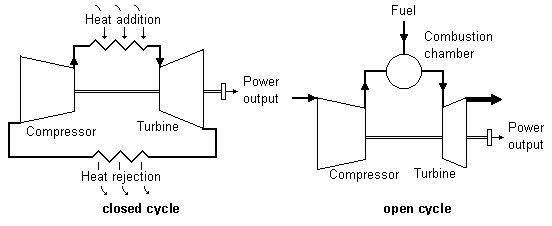
Figure 13: Gas turbine cycles

If the fluid employed is recycled the turbine works on closed cycle, whereas if the fluid is not re-used it is open cycle.
Ideal gas turbine cycles are based on the Joule or Brayton cycles, ie, compression and expansion at constant entropy, and heat addition and release at constant pressure (Harman (1981)) . In an ideal cycle, efficiency varies with the temperature ratio of the working fluid in the compression process, which is related to its pressure ratio. The inlet temperature in the turbine section is generally limited by turbine technology, materials strength, corrosion and other considerations. The increment of temperature also depends on the initial temperature of the working fluid.
Various process modifications can be applied to improve the thermal efficiency of gas turbines. For example, regeneration improves efficiency by transferring waste heat to the inlet air, thus reducing fuel consumption. Co-generation is a process where the exhaust gases are used to raise steam in a boiler. The steam can be used in a different application, be it an industrial process, district heating, etc. The quality of the fuel used must be higher as contaminants likely to produce corrosion must be avoided. In combined cycles, the waste heat generated in a gas turbine is re-directed to a boiler in order to drive a steam turbine. Both the gas turbine and the steam turbine generate electricity.
Some effects must be considered which diminish efficiency in real operating cycles, such as inefficiency in compression and expansion, loss of pressure during heat addition and rejection, variation of working fluid specific heat with temperature, incomplete combustion, etc.
 Previous |  Table of Contents |  Next |